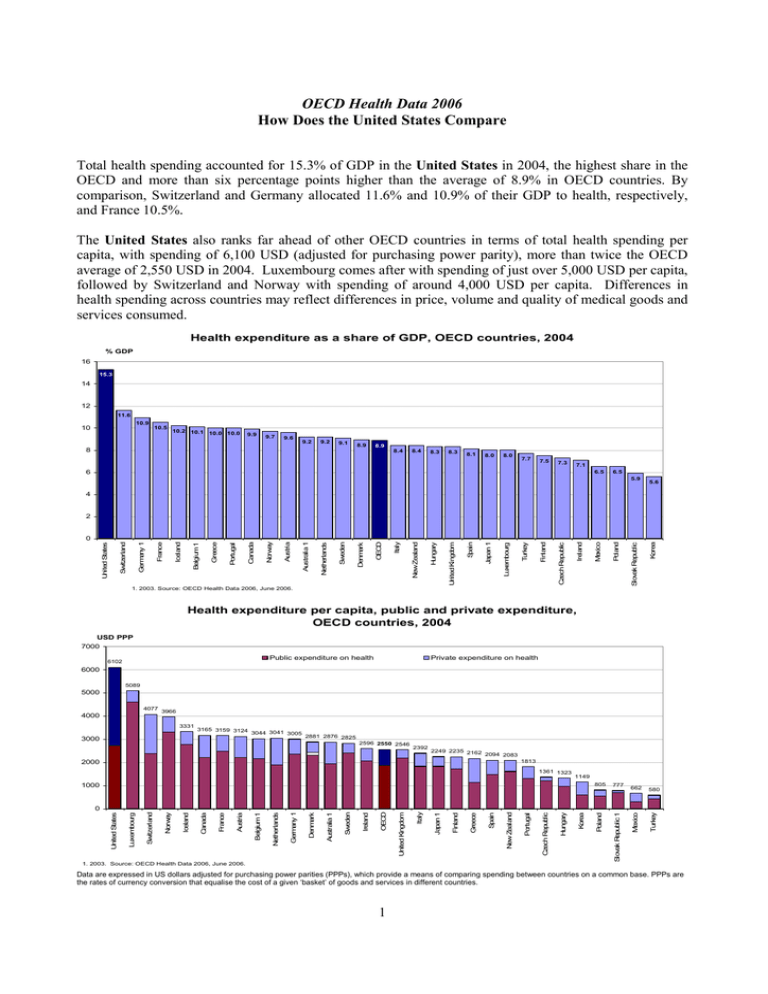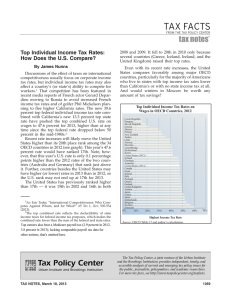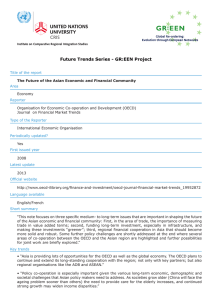OECD Health Data 2006 How Does the United States Compare
advertisement

OECD Health Data 2006 How Does the United States Compare Total health spending accounted for 15.3% of GDP in the United States in 2004, the highest share in the OECD and more than six percentage points higher than the average of 8.9% in OECD countries. By comparison, Switzerland and Germany allocated 11.6% and 10.9% of their GDP to health, respectively, and France 10.5%. The United States also ranks far ahead of other OECD countries in terms of total health spending per capita, with spending of 6,100 USD (adjusted for purchasing power parity), more than twice the OECD average of 2,550 USD in 2004. Luxembourg comes after with spending of just over 5,000 USD per capita, followed by Switzerland and Norway with spending of around 4,000 USD per capita. Differences in health spending across countries may reflect differences in price, volume and quality of medical goods and services consumed. Health expenditure as a share of GDP, OECD countries, 2004 % GDP 16 15.3 14 12 11.6 10.9 10 10.5 10.2 10.1 10.0 10.0 9.9 9.7 9.6 9.2 9.2 9.1 8 8.9 8.9 8.4 8.4 8.3 8.3 8.1 8.0 8.0 7.7 7.5 7.3 7.1 6 6.5 6.5 5.9 5.6 4 2 Slovak Republic Korea Slovak Republic 1 662 580 Turkey Poland 777 Mexico Mexico 805 Poland Ireland Czech Republic Turkey Finland Japan 1 Luxembourg Spain Hungary 1. 2003. Source: OECD Health Data 2006, June 2006. United Kingdom Italy New Zealand OECD Denmark Sweden Netherlands Austria Australia 1 Norway Canada Portugal Greece Belgium 1 Iceland France Germany 1 United States Switzerland 0 Health expenditure per capita, public and private expenditure, OECD countries, 2004 USD PPP 7000 Public expenditure on health 6102 Private expenditure on health 6000 5089 5000 4077 4000 3966 3331 3000 3165 3159 3124 3044 3041 3005 2881 2876 2825 2596 2550 2546 2392 2249 2235 2162 2094 2083 1813 2000 1361 1323 1149 1000 1. 2003. Source: OECD Health Data 2006, June 2006. Korea Hungary Czech Republic Portugal New Zealand Spain Greece Finland Japan 1 Italy United Kingdom OECD Ireland Sweden Australia 1 Denmark Germany 1 Netherlands Belgium 1 Austria France Iceland Canada Norway Switzerland Luxembourg United States 0 Data are expressed in US dollars adjusted for purchasing power parities (PPPs), which provide a means of comparing spending between countries on a common base. PPPs are the rates of currency conversion that equalise the cost of a given ‘basket’ of goods and services in different countries. 1 Between 1999 and 2004, health spending per capita in the United States increased in real terms by 5.9% per year on average, a growth rate exceeding the OECD average of 5.2% per year. Over the past decade, the share of health expenditure spent on pharmaceuticals in the United States increased from 8.5% of total health spending in 1994 to 12.3% in 2004. This remained below the OECD average of 17.7%. In 2004, the United States was the top spender on pharmaceuticals (with 752 USD per capita), followed by France. The public sector is the main source of health funding in all OECD countries, except for the United States and Mexico. In the United States, only 45% of health spending is funded by government revenues, well below the average of 73% in OECD countries. The public share of total health spending remains the lowest among OECD countries. On the other hand, private insurance accounts for 37% of total health spending in the United States, by far the largest share among OECD countries. Beside the United States, Canada, France and the Netherlands also have a relatively large share of health spending paid by private insurance (more than 12%). Resources in the health sector (human, physical) Despite the relatively high level of health expenditure in the United States, there are fewer physicians per capita than in most other OECD countries. In 2004, the United States had 2.4 practising physicians per 1 000 population, below the OECD average of 3.0. There were 7.9 nurses per 1 000 population in the United States in 2002, which is slightly lower than the average of 8.3 across OECD countries. The number of acute care hospital beds in the United States in 2004 was 2.8 per 1 000 population, also lower than the OECD average of 4.1 beds per 1 000 population. As in most OECD countries, the number of hospital beds per capita has fallen over the past twenty-five years, from 4.4 beds per 1 000 population in 1980 to 2.8 in 2004. This decline has coincided with a reduction in average length of stays in hospitals and an increase in day-surgery patients. Health status and risk factors Most OECD countries have enjoyed large gains in life expectancy over the past 40 years. In the United States, life expectancy at birth increased by 7.6 years between 1960 and 2003, which is less than the increase of over 14 years in Japan, or 8.6 years in Canada. In 2003/4, life expectancy in the United States stood at 77.5 years, below the OECD average of 78.3 years. Japan, Iceland, Switzerland, Sweden and Australia were the 5 countries registering the highest life expectancy. Infant mortality rates in the United States have fallen greatly over the past few decades, but not as much as in most other OECD countries. It stood at 6.9 deaths per 1 000 live births in 2003, above the OECD average of 5.7.1 Among OECD countries, infant mortality is the lowest in Japan and in the Nordic countries (Iceland, Sweden, Norway and Finland), with rates all below 3.5 deaths per 1 000 live births. The proportion of daily smokers among the adult population has shown a marked decline over recent decades across most OECD countries. Much of this decline can be attributed to policies aimed at reducing tobacco consumption through public awareness campaigns, advertising bans and increased taxation. In the United States, the proportion of smokers among adults has been cut in half over the past twenty-five years, 1 Some of the international variation in infant mortality rates is due to variations in registering practices of premature infants (whether they are reported as live births or not). In the United States, Canada and the Nordic countries, very premature babies (with relatively low odds of survival) are registered as live births, which increases mortality rates compared with other countries that do not register them as live births. 2 falling from 33.5% in 1980 to 17.0% in 2004, the lowest rate among OECD countries after Canada and Sweden. At the same time, obesity rates have increased in recent decades in all OECD countries for which trend data is available. There remain however notable differences in obesity rates across countries. In the United States, the obesity rate among adults (30.6% in 2002) is the highest in OECD countries, followed by Mexico (24.2% in 2000), the United Kingdom (23.0% in 2004) and Canada (22.4% in 2004).2 Obesity rates in Continental European countries are lower, but are also rising. The time lag between the onset of obesity and increases in related chronic diseases (such as diabetes, cardiovascular diseases and asthma) suggest that the rise in obesity that has occurred in the United States and other OECD countries will have substantial implications for future incidence of health problems and related spending. More information on OECD Health Data 2006 is available at www.oecd.org/health/healthdata. For more information on OECD's work on the United States, please visit www.oecd.org/us. 2 It should be noted however that the data for the United States, the United Kingdom, Australia, New Zealand and Canada (2004) are more accurate than those from other countries since they are based on actual measures of people’s height and weight, while estimates for other countries are based on self-reported data, which generally under-estimate the real prevalence of obesity. 3






